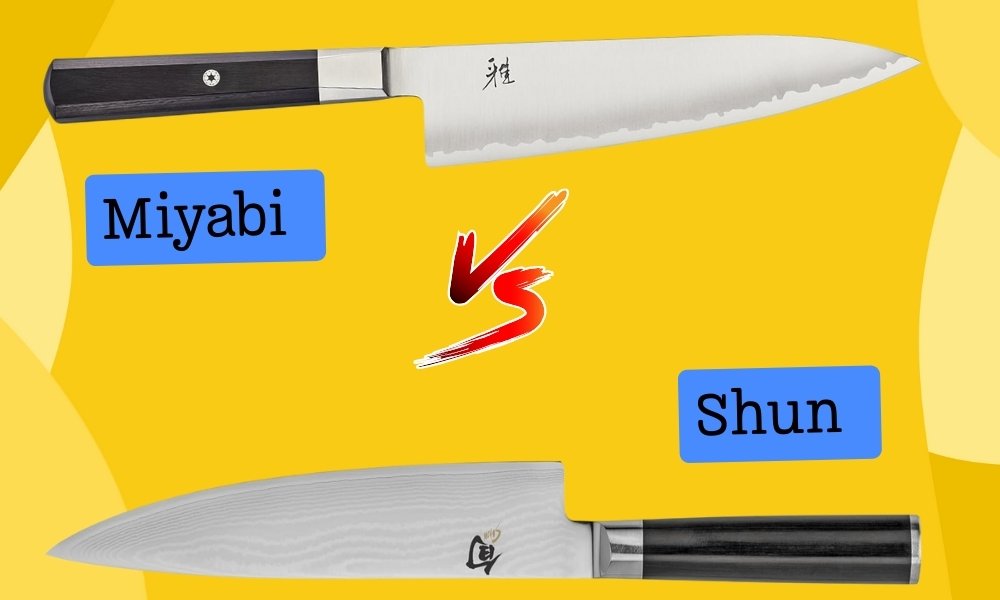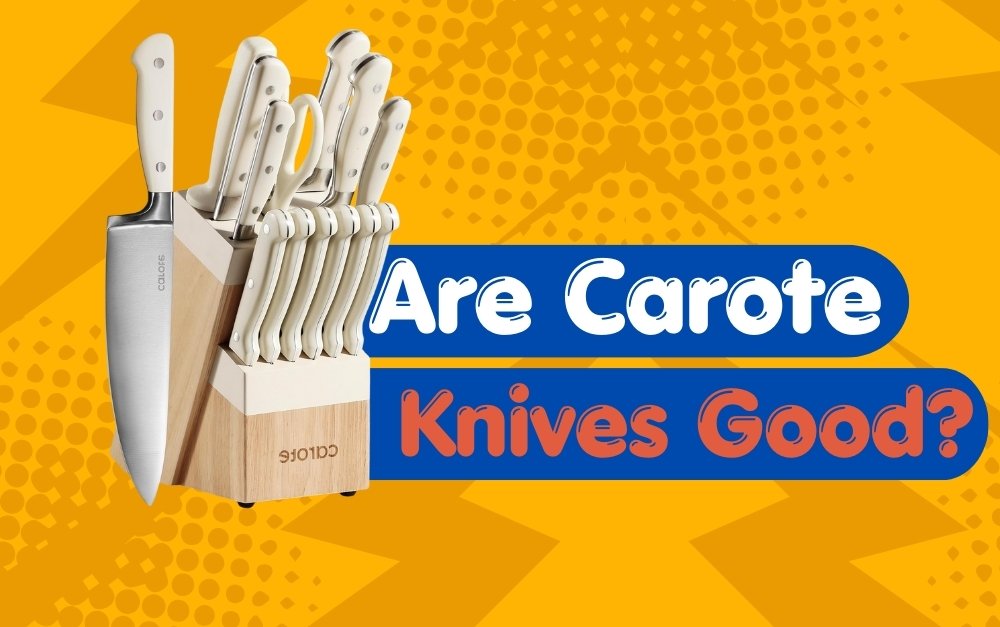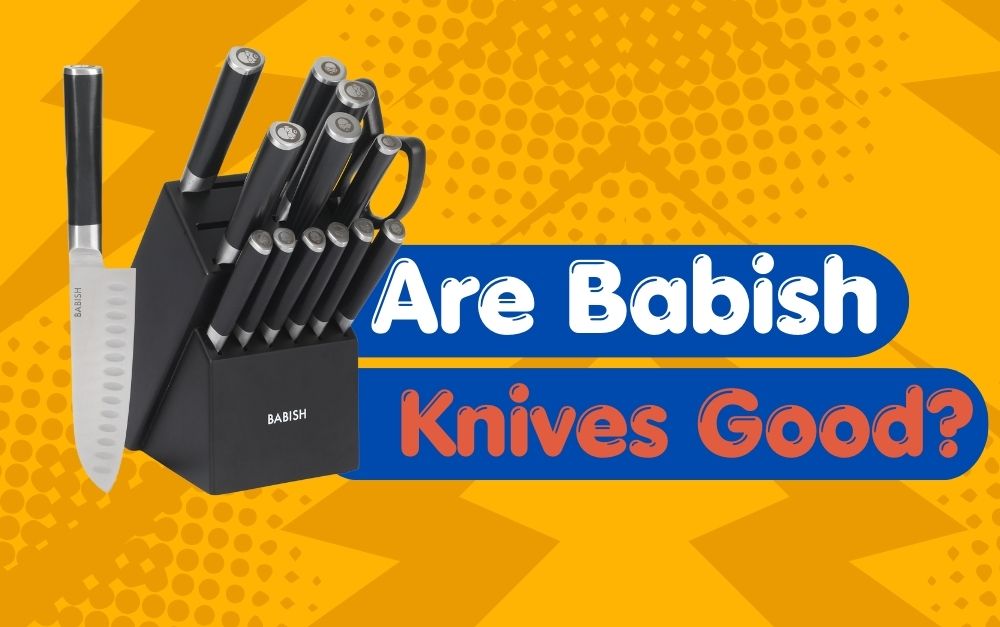Introduction
If you’re asking which knife is better — Miyabi vs Shun, here’s my take.The Miyabi is razor-sharp and perfect for fine, delicate cuts. The Shun is sharp too but feels steadier for daily cooking.
I’ve used both for years, from slicing herbs thin as air to chopping big piles of vegetables.Here’s what I learned so you can pick the knife that fits your cooking style best.
Is the Miyabi Koh 8-inch Chef’s Knife Good?
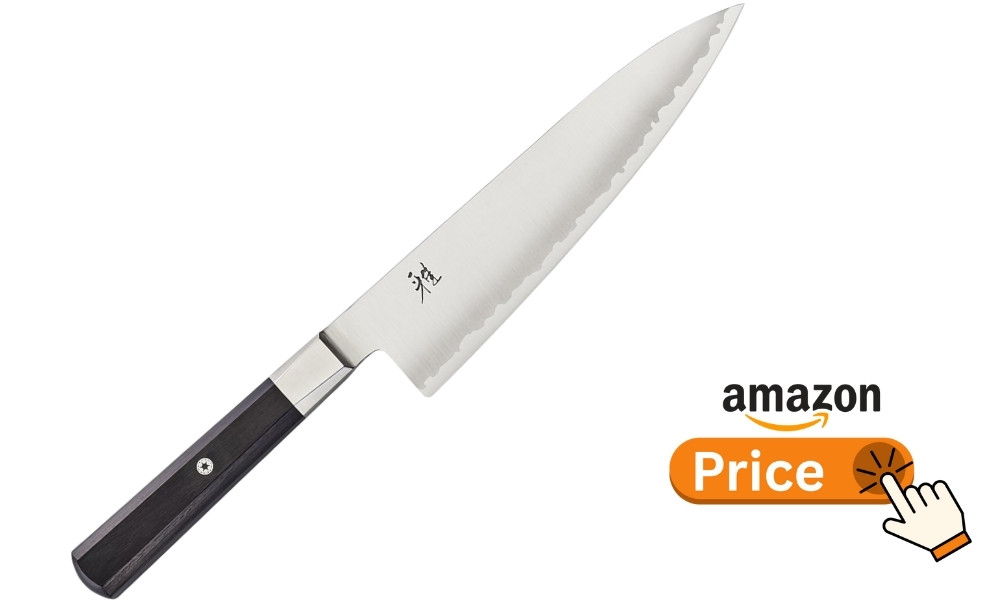
Yes — the Miyabi Koh 8-inch Chef’s Knife is a tool that blends Japanese craftsmanship with modern precision. I’ve used it in my own kitchen for everything from slicing onions to breaking down a roast chicken. It’s light in the hand, razor-sharp, and stays that way longer than many knives I’ve owned.
One evening, I prepped an entire stir-fry — carrots, bell peppers, beef — without needing to stop and hone the edge. Another time, I used it for delicate tomato slices without crushing a single seed. That’s when I realized this wasn’t just a pretty knife — it’s a performer.
Technical highlights (made easy to read):
- Blade steel: FC61 fine carbide stainless steel, hardened to ~61 HRC.
- Edge: Honbazuke hand-honed, 9.5°–12° per side for incredible sharpness.
- Design: Slim profile with a comfortable D-shaped handle for control.
- Origin: Made in Seki, Japan, by Zwilling’s Miyabi division.
What I Like
- Effortless slicing – The narrow, hand-honed edge slides through vegetables and meat with almost no resistance. I feel less fatigue even after long prep sessions.
- Balance and control – The D-shaped handle feels secure, even when my hands are damp. This matters in fast-paced cooking, where slips can mean injuries.
- Edge retention – I’ve gone weeks without sharpening, even with daily use. For home cooks in the USA who value low maintenance, this is a big plus.
- Elegant design – The satin-finished blade and minimalist look make it stand out without being flashy. Guests often ask about it.
What Could Be Better
- Price point – It’s in the premium range. At around $160–$180, it’s more of an investment than entry-level chef knives.
- Not for rough work – I wouldn’t use it for frozen foods or heavy bones; the fine edge is built for precision, not abuse.
- Handle fit – The D-shape may not suit everyone, especially left-handed cooks, unless they try it first. An ambidextrous option would widen its appeal.
Recommendation
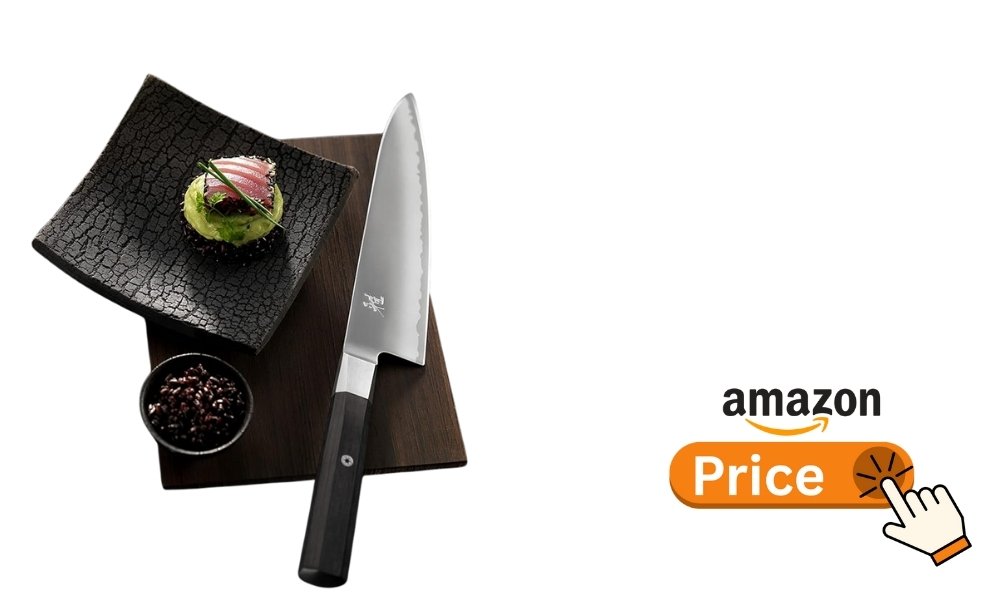
If you’re a cook who values sharpness, balance, and Japanese-style precision, the Miyabi Koh 8-inch Chef’s Knife is worth every penny.
It’s perfect for home chefs who cook often, enjoy detailed prep work, and want a knife that stays sharp with minimal upkeep.
If you’re rough on knives, cut through bones, or need a more forgiving edge, you might look at something like a Shun Classic or a German-made Wüsthof — both are tougher and easier to maintain.
For USA buyers: the Miyabi Koh is widely available online and at specialty kitchen stores, so you can test the handle before committing. Plus, Zwilling’s U.S. warranty and sharpening service make ownership easier.
Is the Shun Classic 8″ Chef’s Knife Good?
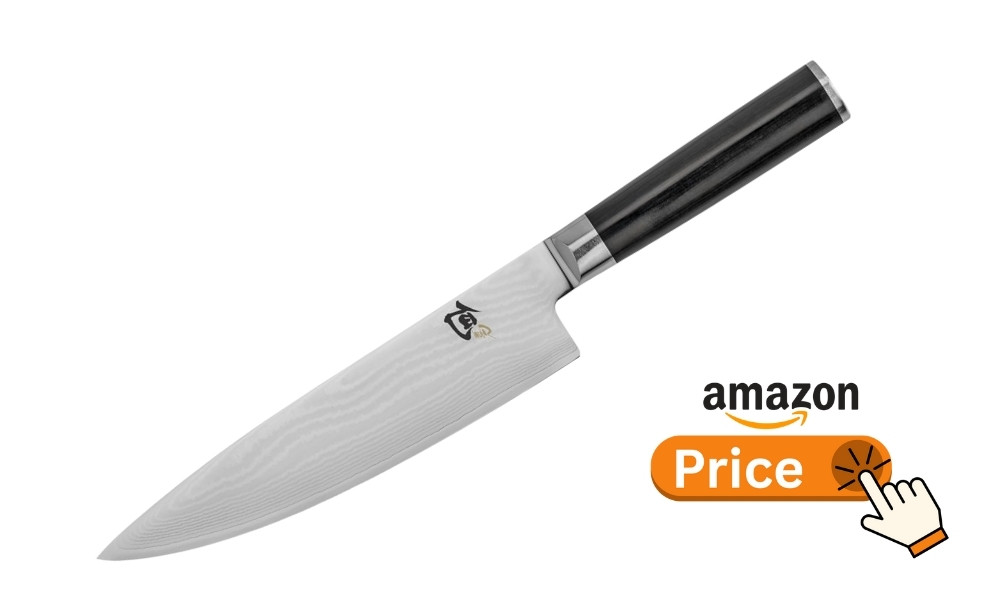
Yes — the Shun Classic 8″ Chef’s Knife is one of the most versatile and reliable knives I’ve ever used. In my kitchen, it has handled everything from dicing onions for a weeknight pasta to carving a roast for a holiday dinner. It feels balanced, stays sharp, and looks beautiful on the counter.
I once prepped an entire pot of chili — chopping peppers, mincing garlic, and slicing beef — without feeling hand fatigue. That’s when I realized why so many professional chefs and serious home cooks recommend it.
Key technical highlights:
- Steel: VG-MAX core with 68 layers of stainless Damascus cladding.
- Edge angle: 16° per side, hand-honed for precision.
- Hardness: ~60–61 HRC for good edge retention.
- Handle: D-shaped pakkawood for grip and comfort.
What I Like
- Effortless cutting – The edge glides through vegetables and proteins without tearing or crushing them. I can slice a ripe tomato cleanly in one motion.
- Balance and comfort – The weight is just right for my hand, making long prep sessions easier. The pakkawood handle feels smooth but secure.
- Long-lasting sharpness – I only need to hone it lightly every couple of weeks, even with daily use.
- Beautiful design – The Damascus pattern and polished finish make it as much a display piece as a tool. Guests often ask where I got it.
What Could Be Better
- Price – It’s an investment. At around $150–$170 in the U.S., it’s more than entry-level knives.
- Not for heavy-duty cutting – I avoid using it on frozen foods or hard bones. The fine edge is meant for precision, not brute force.
- Handle shape – The D-shape is best for right-handed users. Left-handed cooks may prefer to test it before buying or look for ambidextrous options.
Recommendation
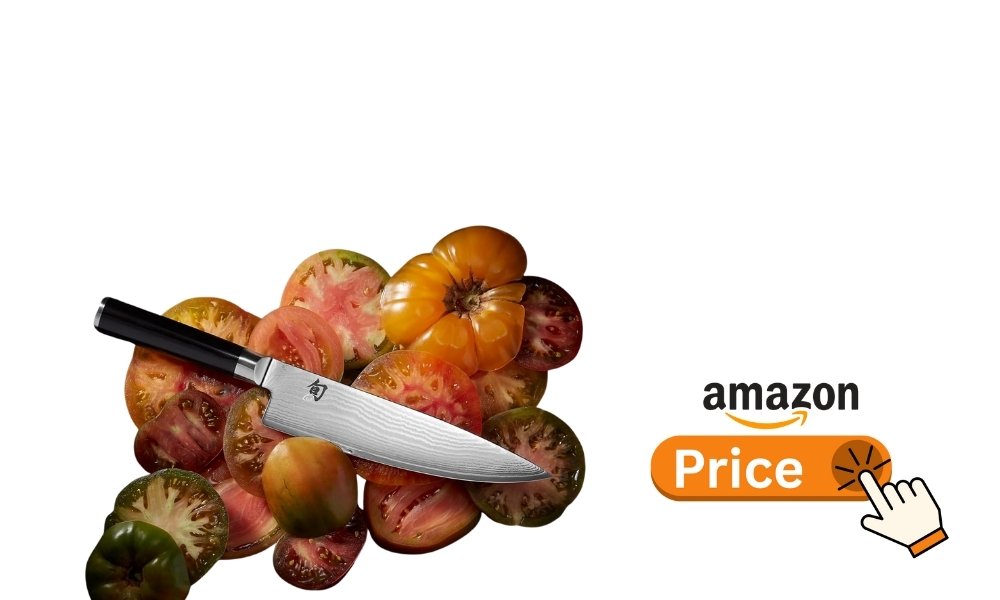
If you’re a home cook or professional who values sharpness, comfort, and Japanese craftsmanship, the Shun Classic 8″ Chef’s Knife is an excellent choice. It works well for most cutting tasks — from chopping herbs to slicing meat — and holds up to daily cooking.
If you tend to be rough on knives or want something more forgiving, a German-made option like a Wüsthof might suit you better. It’s less sharp out of the box but tougher for heavy-duty work.
For U.S. buyers: The Shun Classic is easy to find both online and in kitchen specialty stores. Shun also offers a free U.S.-based sharpening service, which adds long-term value
Miyabi vs Shun — Comparison
I’ve used both the Miyabi Koh and Shun Classic in my own kitchen for months.
They’re both beautiful Japanese chef’s knives, but they feel and work a bit differently.
Here’s what I found when I put them side by side in real cooking.
Sharpness and Cutting Feel
The Miyabi Koh feels like it wants to glide through food.
I remember slicing a ripe tomato and the skin just fell away — no pressure, no tearing.
The Shun Classic is also sharp, but with its slightly wider edge angle, it feels a bit sturdier for tougher veggies.
| Attribute | Miyabi Koh | Shun Classic |
| Edge angle | 9.5°–12° per side | 16° per side |
| Sharpness feel | Laser-like, super fine cuts | Very sharp, a touch more forgiving |
| Best for | Paper-thin veggie slices, delicate prep | All-round slicing with slight toughness |
| Edge retention | Excellent, weeks without honing | Great, light honing every 2–3 weeks |
| First impression | Ultra precise | Balanced sharpness + durability |
Winner: Miyabi Koh — it’s sharper and glides like nothing else.
Rating: 4.9/5
Comfort and Balance
The Miyabi Koh’s D-shaped handle fits my hand like a glove, but it’s very light.
The Shun Classic has a bit more weight in the blade, which makes chopping herbs feel effortless.
Both are comfy, but the Shun’s pakkawood handle has a warmer, more organic feel.
| Attribute | Miyabi Koh | Shun Classic |
| Handle shape | D-shaped, slim | D-shaped, fuller |
| Weight feel | Light and nimble | Slightly heavier, steady |
| Best for | Fast slicing, precision work | Chopping, rocking cuts |
| Grip comfort | Secure, even with damp hands | Smooth yet grippy pakkawood |
| Fatigue level | Very low | Low |
Winner: Shun Classic — that extra weight makes long prep easier.
Rating: 4.8/5
Build and Materials
The Miyabi Koh uses FC61 fine carbide steel, which is hard and keeps a keen edge.
The Shun Classic has VG-MAX steel with 68 layers of Damascus, so it’s not just tough but also stunning.
Both are well-made in Japan, but the Shun’s layered design gives it more visual wow.
| Attribute | Miyabi Koh | Shun Classic |
| Core steel | FC61 | VG-MAX |
| Hardness (HRC) | ~61 | ~60–61 |
| Finish | Satin | Damascus |
| Origin | Seki, Japan | Seki, Japan |
| Look factor | Minimalist elegance | Eye-catching patterns |
Winner: Shun Classic — beauty and strength in one.
Rating: 4.9/5
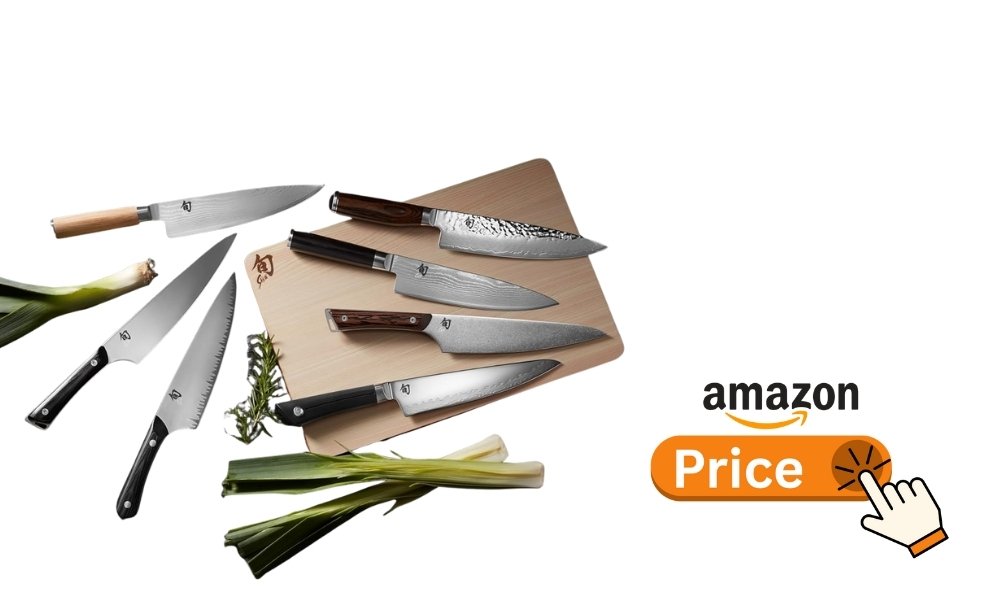
Durability and Maintenance
The Miyabi Koh holds an edge a little longer in my experience.
I’ve gone weeks without touching a honing rod.
The Shun needs a bit more frequent honing, but it shrugs off minor misuse better.
| Attribute | Miyabi Koh | Shun Classic |
| Edge retention | Excellent | Very good |
| Chip resistance | Lower — fine edge | Higher — slightly thicker edge |
| Maintenance need | Very low | Low |
| Sharpening ease | Needs fine stones | Works with common stones |
| Best for care style | Careful cooks | All-round use |
Winner: Miyabi Koh — less maintenance if you handle it gently.
Rating: 4.8/5
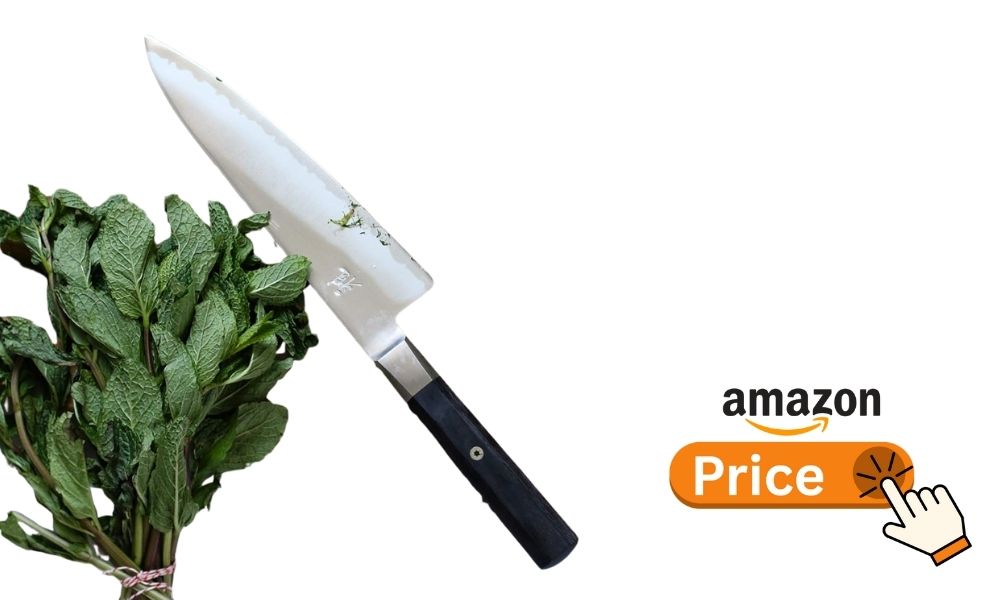
Overall Cooking Experience
Using the Miyabi Koh feels like precision surgery — every slice is clean and even.
The Shun Classic feels more like a friendly workhorse that still looks amazing.
I keep both, but I reach for the Miyabi when I want finesse and the Shun when I’m in a hurry.
| Attribute | Miyabi Koh | Shun Classic |
| Style | Precision tool | All-rounder |
| Learning curve | Slight | Very low |
| Best mood match | Slow, mindful cooking | Fast, everyday meals |
| Looks | Modern minimal | Classic Damascus |
| “Reach for it” factor | When I want perfect cuts | When I want speed |
Winner: Tie — they shine in different moods.
Rating: 4.85/5
.
Final Thoughts
If you love knives that feel like an extension of your hand, both the Miyabi Koh and Shun Classic can make cooking feel like play instead of work. I reach for the Miyabi when I want razor precision, like slicing herbs so fine they almost melt into a dish. The Shun is my go-to when I’m moving fast and need a blade that forgives a little roughness. Neither will let you down, but knowing your style in the kitchen will tell you which one feels like it was made just for you.
FAQs — Miyabi Koh vs Shun Classic Chef’s Knives
Q1: Which is sharper, the Miyabi Koh or the Shun Classic?
A: The Miyabi Koh has a finer edge angle, making it sharper for precision cuts, while the Shun Classic feels a bit sturdier.
Q2: Which chef’s knife holds its edge longer?
A: In my use, the Miyabi Koh stays sharp a bit longer, but the Shun Classic is easier to hone back to a great edge.
Q3: Is the Miyabi Koh 8-inch Chef’s Knife good for everyday cooking?
A: Yes. It’s light, sharp, and perfect for daily prep, though it’s best for careful use rather than heavy chopping.
Q4: Is the Shun Classic 8-inch Chef’s Knife durable?
A: Yes. Its slightly thicker edge and Damascus layers make it tough enough for daily use with proper care.
Q5: Which knife is better for beginners — Miyabi Koh or Shun Classic?
A: The Shun Classic is more forgiving for new cooks, while the Miyabi Koh rewards a light, precise cutting style.
Q6: Are both knives made in Japan?
A: Yes. Both are crafted in Seki, Japan, known for blending traditional techniques with modern knife-making.
Q7: Which is better for left-handed cooks?
A: Both have right-handed D-shaped handles, so left-hand users should try them first or look for ambidextrous versions.
Q8: Can I cut bones with these knives?
A: No. Both are made for precision slicing, not heavy bone chopping. Use a cleaver for that job.
Q9: Which has the better handle comfort?
A: The Miyabi Koh is slim and light, while the Shun Classic’s pakkawood handle feels fuller and warmer in the hand.
Q10: Which is the better investment for a home chef?
A: If you value razor precision, go for the Miyabi Koh. If you want beauty with durability, the Shun Classic shines.
